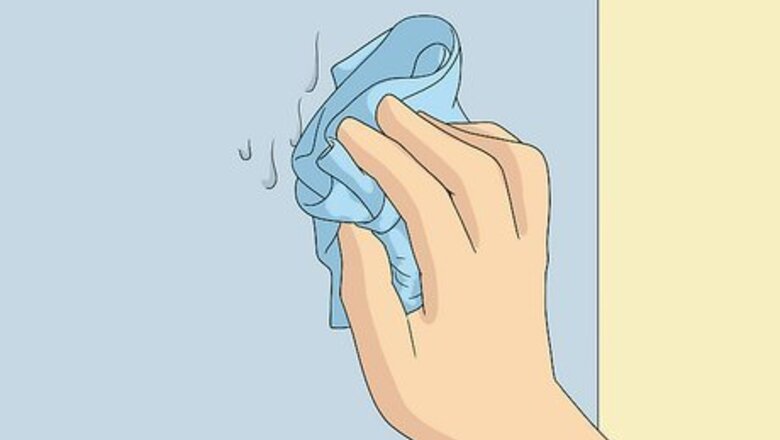
views
Wet Runs

Wipe the drip with a lint-free rag if you spot the mistake right away. If you spot a drip, your first impulse might be to grab a rag and wipe the drip away. You can certainly do this if you spot the running paint while it’s still totally wet, but you must use a totally dry, lint-free cloth. Blot the dripping paint to soak the excess up and quickly re-paint the area to make it uniform. If you use a wet, dirty, or thick-napped cloth, fibers or dust from the cloth may end up stuck in your paint job. If you’re brush painting and it starts running, you can try moving the brush back and forth over the area to spread the excess paint out. You may need to use a cloth for huge drips, though. If you’re using a roller and the sides drip as you paint, it’s a sign you’re overloading the roller in the paint tray. Luckily, this is a super easy thing to fix. Just move the roller over the area 2-3 times in an overlapping zigzag pattern. This will remove any drips.
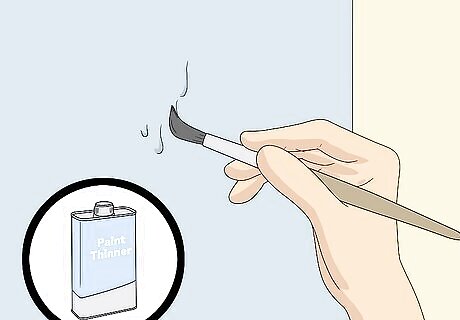
Use a small bit of paint thinner if the drip has skinned over the metal. If you spot a drip but it has already started to dry a bit, the rag won’t remove all of the paint. Fill a small cup with a little bit of paint thinner. Grab a small artist’s brush and dip the bristles into the paint thinner. Lightly brush the paint thinner over the center of the drip. Less is more, so give it a few brushstrokes and wait a second to see if you need to keep brushing. The paint thinner will weaken up the hardened paint and thin it out. However, if you overdo it with the solvent, you may end up revealing the metal underneath the surrounding paint. You can fix this if it happens, but try not to go crazy with the paint thinner. If there’s still an outline of the drip after your first few strokes, dip the brush in a little more solvent and trace it with your brush. Continue doing this until the skinned-over paint is gone. Use a lacquer thinner if you’re painting a vehicle with automotive paint.

Blend the drip into the surrounding paint with your artist’s brush. Do not reload your brush with more solvent once the skinned-over paint is weakened. Simply move your brush back and forth to spread out the weakened paint and work it back into the surrounding metal. Continue doing this until you achieve a uniform, even coat. This is really more of an art than a science. Don’t get frustrated while you’re doing this if you can’t get it to look just the way you want. If necessary, you can always repaint the area.

Repaint your metal surface once the touched-up area dries if necessary. If the surrounding paint is still wet, you can repaint the area now to cover any blemishes. If most of the paint has dried out in the area though, wait 24 hours for the paint to dry out completely. Then, repaint the discolored area with your brush, roller, or spray paint. Paint a little further than the area you fixed to blend the paint together. For example, if you used your solvent to brush out a 5 by 5 in (13 by 13 cm) section of drips, repaint an area roughly 8 by 8 inches (20 by 20 cm) or bigger. This will help cover the edges where you were working and hide the correction. If the area ends up looking kind of splotchy or the repainted area stands out a lot, you may need to repaint the entire item to blend it in.
Dried Runs
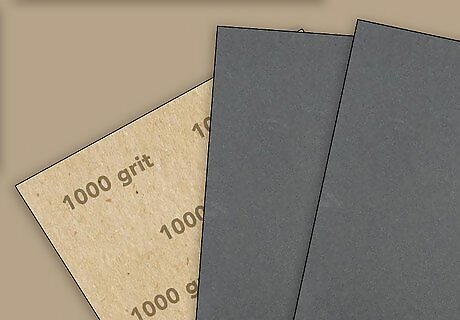
Grab some fine-grit sandpaper to remove the drips. Anything around 1000-grit sandpaper should work for this. You can use a drywall sponge or a sheet of sandpaper depending on what you have laying around. Don’t use an orbital sander. You don’t need a ton of friction to remove dried drips, and an orbital sander is very likely to reveal the primer or metal underneath the paint.
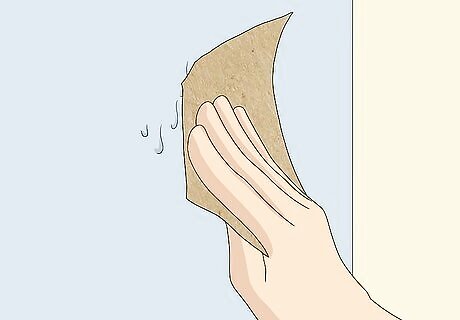
Sand the drip down gently to remove excess paint from the metal. Take your sandpaper and slowly rub it back and forth over the drip to wear it down. Increase the pressure slowly if it isn’t wearing away. Stop once you’ve stripped enough of the paint away to create the appearance of a single, uniform layer of paint. If the paint is super hard to remove, either use a coarser grit of sandpaper or apply firmer pressure. You may end up scratching the surrounding paint, but you can always fix that.

Use a clean cloth to wipe the dust away. Once you’ve sanded the drip down, there will be dust and shreds of paint pigment all over the metal. Grab a dry, lint-free cloth and wipe the area down to remove this dust. Use a combination of back-and-forth strokes and circular wipes to ensure that you wipe away any residue from your sandpaper. If you use a dirty rag or a cloth with a nap that comes off, you may end up with dirt and small fabric sticking to your paint. If the paint looks uniform and even, you can stop after you’ve wiped the dirt away. There’s no need to repaint if you’ve restored the original paint job!
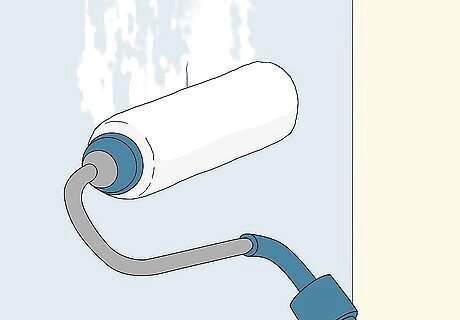
Repaint the portion of metal you sanded if there’s any discoloration. If you removed too much paint or you scuffed the surface up, it’s worth repainting the area. Grab your paint sprayer, spray paint, or brush, and repaint the area the same way you originally did with your brush, roller, or spray paint. Any scuff marks from the sandpaper will stand out. You may not need to do a ton of repainting here. One or two swipes with your spray paint or brush should cover the area just fine. Wait 24 hours after repainting to see how it looks once it is dry. Since sanding literally removes a layer of paint, putting that layer back should blend it in fairly well. If the repainted area looks kind of inconsistent with the rest of your paint job, wait at least 24 hours and repaint the entire object or surface again. A second coat will cover up your work.
Prevention

Hold the nozzle 6–8 in (15–20 cm) away if you’re spray painting metal. If you’re using a paint sprayer or can of spray paint, holding the nozzle super close to the surface will lead to drips. However, holding the can too far away will lead to an uneven coat. Keep the nozzle 6–8 inches (15–20 cm) away from the surface at all times while you’re holding the trigger down. This way, you’ll have a steady control over the can, you’ll get an even coat, and the paint won’t run while you work. Don’t paint outside if it’s super windy out. You’ll need to keep the can super close to the metal if it’s windy but it’s hard to avoid drips if you hold the can that closely to the surface.
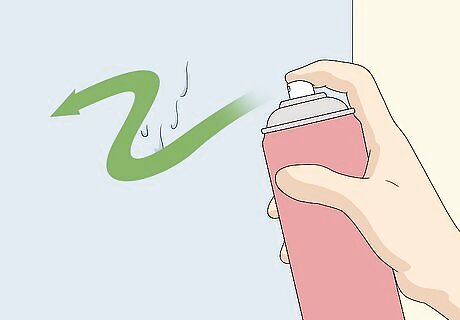
Keep the can moving continuously while spray painting. If you’re using a spray gun or spray paint, never hold the nozzle down without moving it. Holding a steady stream of paint in one place for more than a second will cause the paint to build up, which can lead to dripping. A bunch of quick, thin layers will always result in a cleaner finish than a heavy, continuous stream of paint anyway. If you’re worried about getting paint all over the place when you’re moving the can back and forth quickly, put a drop cloth down or use painter’s tape to cover any areas you want to keep dry.
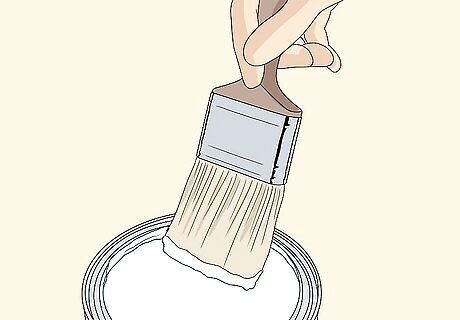
Load the very tip of the bristles if you’re brush painting. If you’re using a paint brush, don’t dip the bristles all the way into the paint. Instead, only dip the bottom 1–1.5 inches (2.5–3.8 cm) of the bristles into the paint before you get to work. You only use the very tip of the bristles to apply paint, and loading the bristles up all the way will cause excess paint to slide down the bristles as you work. You’re also much less likely to get an even coat of paint if you overload the bristles. Even if you don’t end up with drips, your paint job won’t feel or look uniform.
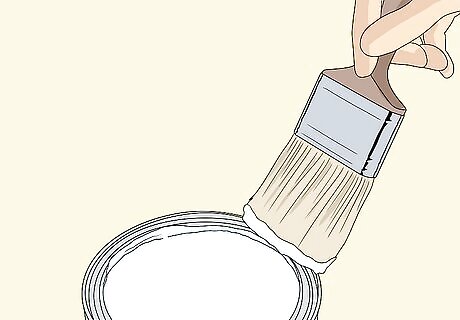
Tap the brush on the side of the can or paint tray before painting with a brush. If you’re brush painting, tap the end of the handle against the side of your paint tray or can after you load the bristles up. This will knock off any big globs of paint that are likely to cause the paint to run on the wall. You don’t need to whack the brush super hard. A gentle 2-3 taps should be more than enough to keep your paint from running.

Brush away from corners to avoid loading them with excess paint. Paint tends to build up really quickly corners and sharp angles, which can cause the paint to run. To avoid this, brush away from corners—not into them. Start ⁄4–⁄2 in (0.64–1.27 cm) away from your corner and drag the bristles away from it. Repeat this process 2-3 times until the paint covers the very edge of the corner and repeat this process on the adjacent surface to get a drip-free finish. If you haven’t started painting yet, get an angled brush! Flat brushes are a lot harder to use if you’re painting something that isn’t perfectly flat.

Overlap each stroke and paint vertically if you use a roller. When you use a roller, paint up and down in column-like sections. Moving the roller horizontally will cause paint to run from the bottom of the roller. After each stroke, cover the edges where you previously painted so that the center of the roller runs over the edges of the previous lines you painted. This will keep paint from building up on the edges of your roller strokes and smooth out potential runs. Rollers may lead to light splatter, but you’re unlikely to end up with a ton of drips. If your roller does drip a lot, it’s a sign you’re dunking the roller in paint and not using the ridges in the paint tray. When you load the roller up, move it 3-5 times along the empty ridges on the top half of the paint tray to clear the excess paint.

















Comments
0 comment